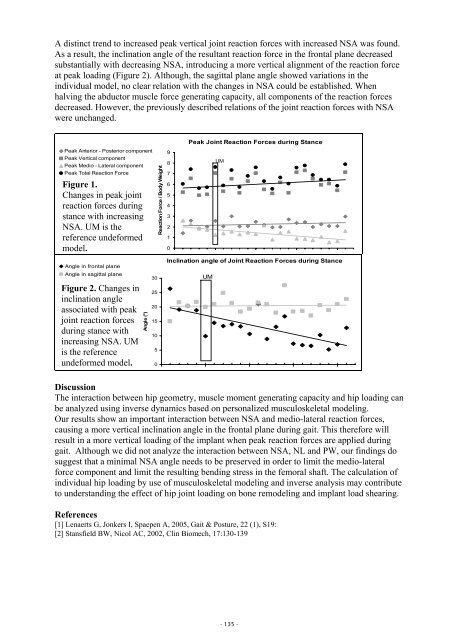1st Joint ESMAC-GCMAS Meeting - Análise de Marcha
1st Joint ESMAC-GCMAS Meeting - Análise de Marcha
1st Joint ESMAC-GCMAS Meeting - Análise de Marcha
You also want an ePaper? Increase the reach of your titles
YUMPU automatically turns print PDFs into web optimized ePapers that Google loves.
A distinct trend to increased peak vertical joint reaction forces with increased NSA was found.<br />
As a result, the inclination angle of the resultant reaction force in the frontal plane <strong>de</strong>creased<br />
substantially with <strong>de</strong>creasing NSA, introducing a more vertical alignment of the reaction force<br />
at peak loading (Figure 2). Although, the sagittal plane angle showed variations in the<br />
individual mo<strong>de</strong>l, no clear relation with the changes in NSA could be established. When<br />
halving the abductor muscle force generating capacity, all components of the reaction forces<br />
<strong>de</strong>creased. However, the previously <strong>de</strong>scribed relations of the joint reaction forces with NSA<br />
were unchanged.<br />
Peak Anterior - Posterior component<br />
Peak Vertical component<br />
Peak Medio - Lateral component<br />
Peak Total Reaction Force<br />
Figure 1.<br />
Changes in peak joint<br />
reaction forces during<br />
stance with increasing<br />
NSA. UM is the<br />
reference un<strong>de</strong>formed<br />
mo<strong>de</strong>l.<br />
Angle in frontal plane<br />
Angle in sagittal plane<br />
Figure 2. Changes in<br />
inclination angle<br />
associated with peak<br />
joint reaction forces<br />
during stance with<br />
increasing NSA. UM<br />
is the reference<br />
un<strong>de</strong>formed mo<strong>de</strong>l.<br />
Angle (°)<br />
30<br />
25<br />
20<br />
15<br />
10<br />
5<br />
0<br />
Reaction Force / Body Weight<br />
9<br />
8<br />
7<br />
6<br />
5<br />
4<br />
3<br />
2<br />
1<br />
0<br />
Peak <strong>Joint</strong> Reaction Forces during Stance<br />
UM<br />
Inclination angle of <strong>Joint</strong> Reaction Forces during Stance<br />
UM<br />
Discussion<br />
The interaction between hip geometry, muscle moment generating capacity and hip loading can<br />
be analyzed using inverse dynamics based on personalized musculoskeletal mo<strong>de</strong>ling.<br />
Our results show an important interaction between NSA and medio-lateral reaction forces,<br />
causing a more vertical inclination angle in the frontal plane during gait. This therefore will<br />
result in a more vertical loading of the implant when peak reaction forces are applied during<br />
gait. Although we did not analyze the interaction between NSA, NL and PW, our findings do<br />
suggest that a minimal NSA angle needs to be preserved in or<strong>de</strong>r to limit the medio-lateral<br />
force component and limit the resulting bending stress in the femoral shaft. The calculation of<br />
individual hip loading by use of musculoskeletal mo<strong>de</strong>ling and inverse analysis may contribute<br />
to un<strong>de</strong>rstanding the effect of hip joint loading on bone remo<strong>de</strong>ling and implant load shearing.<br />
References<br />
[1] Lenaerts G, Jonkers I, Spaepen A, 2005, Gait & Posture, 22 (1), S19:<br />
[2] Stansfield BW, Nicol AC, 2002, Clin Biomech, 17:130-139<br />
- 135 -
















